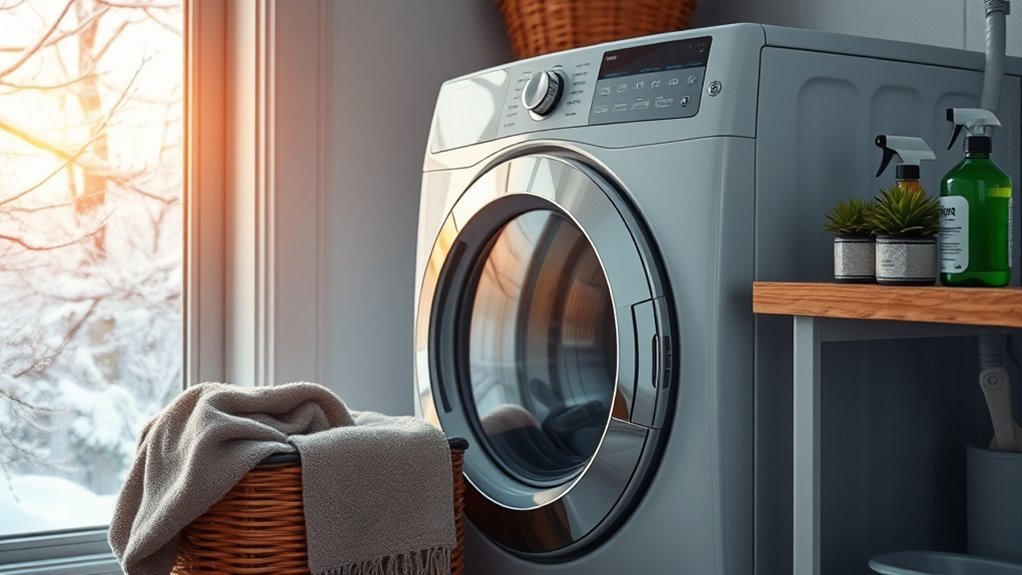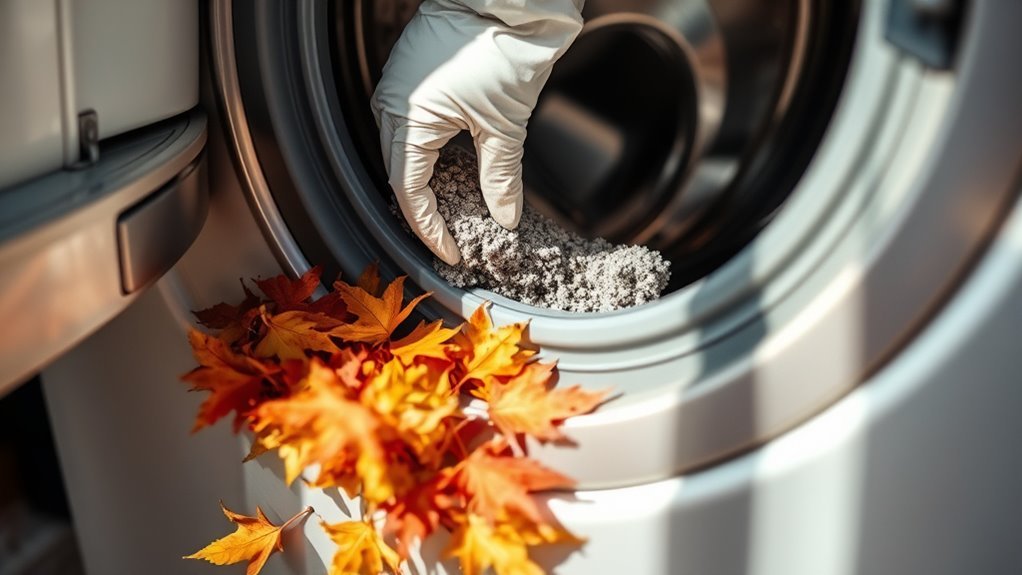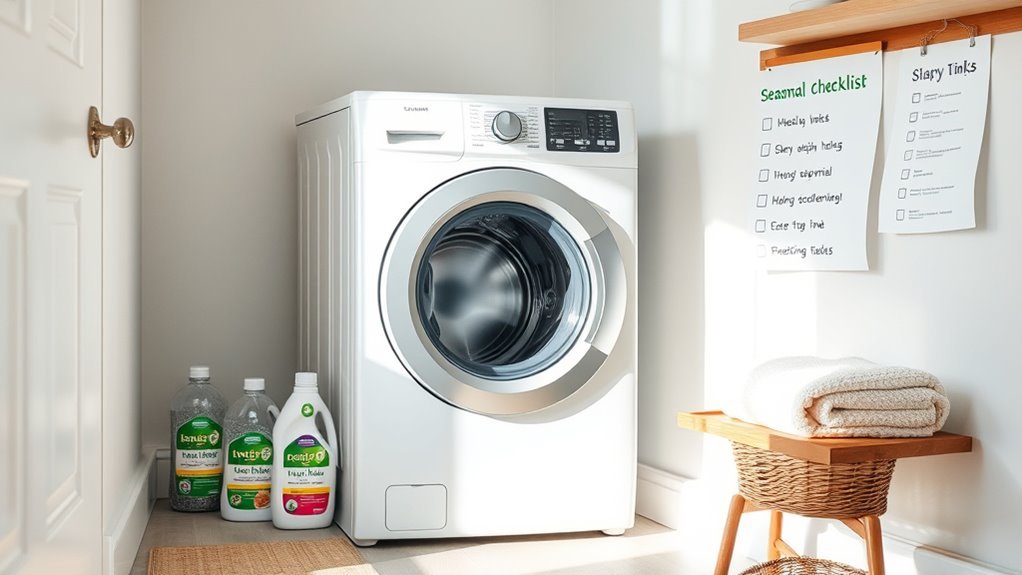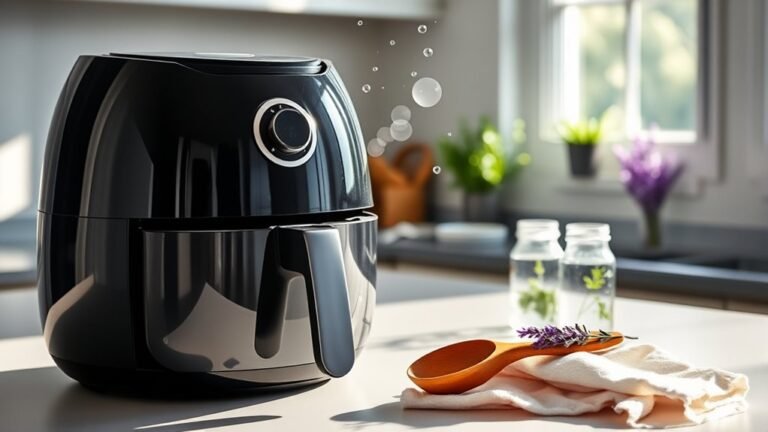Seasonal Maintenance Tips for Washer
You’ll want to prep your washer for winter by draining hoses and using warmer water to avoid freezing. In summer, keep it dry and ventilated to prevent mold. Spring calls for deep cleaning with vinegar and scrubbing drum seals, while autumn requires clearing drains and checking for clogs. Don’t forget to inspect hoses regularly and replace parts as needed. Following these seasonal tips will keep your washer running smoothly all year—and there’s plenty more to help you care for it effectively.
Preparing Your Washer for Winter

Before the cold sets in, you’ll want to take steps to prepare your washer for winter to avoid damage from freezing temperatures. You can embrace simple winterization techniques that protect your machine and keep it running smoothly. Start by adjusting the temperature settings on your washer; cooler water cycles may not be enough to prevent freezing in pipes or hoses. Instead, set your washer to use warmer water during colder months. Also, drain any remaining water from hoses and the washer’s pump to prevent ice buildup and potential cracks. If your washer is in an unheated space, consider insulating pipes or moving the unit indoors. These straightforward actions give you the freedom to enjoy winter without worrying about costly repairs or interruptions in your laundry routine.
Preventing Mold and Mildew in Summer
While warmer weather brings more laundry, it also creates the perfect environment for mold and mildew to develop in your washer. To keep your machine fresh, focus on humidity control by keeping the laundry area dry. Use a dehumidifier or air conditioner if necessary to reduce moisture levels. Ventilation tips like leaving the washer door and detergent drawer open after each use let air circulate, helping prevent dampness buildup. Wipe down seals and surfaces regularly to remove any moisture or residue that can foster mold growth. Taking these simple steps gives you the freedom to enjoy clean clothes without worrying about musty smells or damage, keeping your washer in top shape throughout the summer months.
Spring Cleaning Tips for Your Washer

Now’s a great time to give your washer a thorough spring cleaning to keep it running smoothly. You’ll want to focus on deep cleaning techniques, preventing mold and mildew, and maintaining the filter and drain. These simple steps can extend your washer’s life and improve its performance.
Deep Cleaning Techniques
To get your washer running like new again, it helps to break down deep cleaning into simple steps you can follow each spring. Start by tackling detergent buildup, which can clog your machine and reduce efficiency. Run a hot water cycle with a cup of white vinegar or a specialized washer cleaner to dissolve residue. For tough stain removal inside the drum, scrub gently with a paste of baking soda and water, focusing on stubborn spots. Don’t forget to clean the detergent drawer and filters to free your washer from hidden grime. These steps give you the freedom to enjoy fresh, clean laundry without worrying about your machine’s performance. Deep cleaning isn’t just maintenance—it’s your key to hassle-free washing all year long.
Mold and Mildew Prevention
After you’ve tackled the deep cleaning steps, it’s important to focus on preventing mold and mildew from forming in your washer. Mold growth thrives in damp, enclosed spaces, so after every use, leave your washer door open to let air circulate and dry out the interior. Wipe down the rubber gasket and seals regularly to remove moisture and detergent residue that encourage mildew buildup. You can also run a monthly maintenance cycle using a washer cleaner or a mixture of white vinegar and baking soda to keep mold growth at bay. Avoid leaving wet clothes inside for long periods, as that invites mildew. By staying proactive with these simple habits, you’ll keep your washer fresh and free from unwanted mold and mildew, preserving its performance and your freedom from foul odors.
Filter and Drain Maintenance
Although you might not think about them often, your washer’s filter and drain play an essential role in keeping your machine running smoothly. Regular filter cleaning is key to preventing clogs that can slow down your washer or cause damage. You can usually find the filter near the bottom front of your machine—just remove it, rinse off any debris, and pop it back in. Equally important is drain inspection. Check the drain hose for any blockages, kinks, or leaks that might hinder proper water flow. Taking these simple steps frees you from unexpected breakdowns and keeps your washer performing at its best. Embrace this routine, and you’ll enjoy hassle-free laundry days and more freedom from costly repairs.
Autumn Maintenance to Avoid Clogs

Since fallen leaves and debris are more common in autumn, you’ll want to take some simple steps to keep your washer’s drainage system clear and prevent clogs. Leaf buildup around your outdoor drainage outlets or near vents can easily find its way into your washer’s drain hose, causing blockages. Regular drain cleaning during this season helps maintain smooth water flow and avoids backup issues. Check your washer’s drain filter more frequently, removing any trapped debris to keep everything running freely. By staying on top of these autumn maintenance tasks, you’ll prevent frustrating clogs that could disrupt your freedom to wash whenever you want. Remember, a little effort now means your washer stays efficient all season long.
How to Handle Hard Water Deposits
When hard water flows through your washer, minerals like calcium and magnesium can build up inside its components, reducing efficiency and potentially causing damage. To keep your washer running freely, focus on regular deposit removal. Start by running an empty hot water cycle with a cup of white vinegar or a specialized washer cleaner designed for hard water deposits. This helps dissolve mineral buildup without harsh chemicals. Avoid letting residue accumulate by repeating this process monthly or as needed. You can also wipe down accessible parts like the detergent drawer and door seal to prevent hardened deposits. Taking these simple steps guarantees your washer stays efficient and prolongs its lifespan, giving you the freedom to wash without worries about hard water’s effects.
Checking and Maintaining Washer Hoses
Keeping your washer free from hard water deposits is just one part of maintenance—you also need to pay attention to the hoses that supply water to your machine. Regular hose inspection is critical to prevent leaks or bursts that could disrupt your freedom from laundry hassles. Look for cracks, bulges, or signs of wear. Don’t wait until a hose fails; timely hose replacement keeps your washer running smoothly and protects your space from water damage.
Here’s a quick checklist for maintaining your washer hoses:
- Inspect hoses every 6 months for damage or stiffness
- Replace rubber hoses every 3-5 years, or sooner if damaged
- Consider braided stainless steel hoses for extra durability
- Verify hose connections are tight but not over-tightened
Taking these steps helps you enjoy worry-free laundry days.
Best Practices for Year-Round Washer Care
To keep your washer running smoothly all year, you’ll want to stick to a regular cleaning routine that prevents buildup and odors. It’s also important to inspect parts like hoses and seals frequently and replace them when they show signs of wear. These simple steps can help you avoid costly repairs and extend your machine’s lifespan.
Regular Cleaning Routine
Although it might seem like a hassle, establishing a regular cleaning routine for your washer is essential to prevent buildup and guarantee it runs efficiently year-round. Sticking to a washer maintenance cleaning schedule lets you avoid costly repairs and keeps your laundry fresh. Here’s how to make the process simple and effective:
- Wipe down the drum and door seals weekly to prevent mold and mildew.
- Run a monthly hot water cycle with a washing machine cleaner or white vinegar.
- Clean the detergent drawer regularly to remove residue buildup.
- Leave the door open after each use to allow the interior to dry out.
Inspect and Replace Parts
Two key parts you should regularly inspect are the hoses and door seals, as worn or damaged components can lead to leaks and costly repairs. Start by mastering part identification; know what each component looks like and where it’s located. This makes spotting wear easier and speeds up repairs. Stick to a replacement schedule—hoses typically last about five years, while door seals might need checking every couple of years depending on usage. Don’t wait for a problem to appear; proactive part replacement keeps your washer running smoothly and gives you the freedom to avoid unexpected downtime. Keep a simple checklist to track inspections and replacements, so your washer stays reliable all year round without any hassle.
Frequently Asked Questions
Can I Use Bleach Safely in My Washer?
You can use bleach safely in your washer if you follow a few simple bleach safety tips. Always dilute bleach properly and never pour it directly onto clothes to avoid damage. Using the bleach dispenser helps protect your washer and clothes. Regular washer maintenance, like cleaning the dispenser and running rinse cycles, guarantees bleach doesn’t build up or harm your machine. This way, you keep your laundry fresh without restrictions or worries.
How Do I Troubleshoot a Washer That Won’T Start?
If your washer refuses to start, it can feel like the universe is conspiring against your laundry day! First, check for faulty power—make sure the outlet’s working and the plug’s secure. Next, inspect the door latch; if it’s not properly closed or broken, your washer won’t budge. You’ve got the freedom to fix it yourself—just troubleshoot step-by-step, and you’ll have that washer humming again in no time.
What Is the Best Detergent for High-Efficiency Washers?
When choosing the best detergent for your high-efficiency washer, you’ll want to pick one specifically designed for HE machines. These detergent types are formulated to produce fewer suds and clean effectively with less water, maximizing your washer’s efficiency benefits. Using regular detergent can cause excess suds and damage your washer. So, grab an HE-labeled detergent to enjoy better cleaning power, save energy, and keep your washer running smoothly without any hassle.
How Often Should I Replace My Washer’S Agitator?
Like the fabled Phoenix, your washer’s agitator has its own lifespan, usually around 5 to 10 years depending on use. You’ll want to watch for replacement signs such as unusual noises, inefficient spinning, or visible wear. Don’t let these issues ground your freedom—swapping the agitator timely keeps your laundry routine smooth and liberates you from unexpected breakdowns. Stay vigilant, and your washer will keep dancing through loads effortlessly.
Is It Necessary to Level My Washer for Optimal Performance?
Yes, leveling your washer is essential for washer stability and smooth operation. If it’s off-balance, it can shake, make noise, or even damage itself. You don’t need to stress; just grab some leveling tools like a spirit level and adjustable wrench. By making sure it’s perfectly balanced, you’ll keep your washer running efficiently and avoid annoying vibrations. It’s a simple step that protects your freedom from unexpected repairs!






